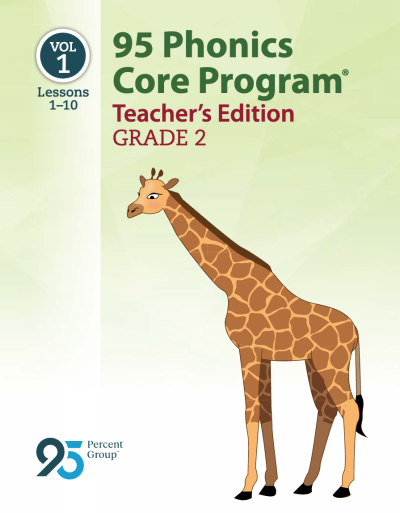Evaluation for 5.C.2c
Materials include a variety of activities and/or resources for students to develop, practice, and reinforce (through cumulative review) their understanding of applying letter-sound correspondence to decode one syllable and multisyllable words in isolation and decodable connected text. (PR 2.A & 2.A.3) (S)
The Teacher's Edition provides opportunities for students to develop, practice, and reinforce applying letter-sound correspondence to decoding one syllable words in isolation. For example, the teacher develops this skill by explicitly modeling the process for decoding a simple one-syllable word, e.g., trip, in isolation: point to the vowel(s) and identify the syllable type, look for an initial consonant blend or consonant digraph, and slide a finger under the word and whisper trip. The teacher then facilitates practice with the skill by having students apply the same process to decode words such as flag, lock, and clip. Opportunities for reinforcement through cumulative review come in a later lesson in the section "Word Reading Accuracy," in which students read closed syllable words (some with initial blends and digraphs, some without) fluently. The Teacher's Edition provides opportunities for students to develop, practice, and reinforce applying letter-sound correspondence to decoding one syllable words in decodable connected text. For example, the teacher develops the skill of decoding words within connected text by guiding students to read the underlined pattern words within the passage. The teacher facilitates practice with this skill by having students whisper reading the underlined words and then the passage as a whole. Opportunities for reinforcement through cumulative review come as the students read later passages with both newly taught phonics patterns as well as previously taught phonics patterns, such as the words "dusk" and "strap" within the text "Tank and the New Kitten" which focuses on the phonograms ang, ing, ong, ank, and ink. The Teacher's Edition provides opportunities for students to develop, practice, and reinforce applying letter-sound correspondence to decoding multisyllabic syllable words in isolation. For example, the teacher develops this skill by explicitly modeling the process for decoding a multisyllabic word with a silent-e syllable, e.g., invade, in isolation: find the vowels, underline the vowels, draw a line between the syllables, read each syllable, and read the word. The teacher then facilitates practice with the skill by having students apply the same process to decode multisyllabic words such as bagpipe, railroad, and coffee. Opportunities for reinforcement through cumulative review come in a later lesson in which students apply the same process to read additional multisyllabic words. The Teacher's Edition provides opportunities for students to develop, practice, and reinforce applying letter-sound correspondence to decoding multisyllabic words in decodable connected text. For example, the teacher develops the skill of decoding words within connected text by guiding students to read the underlined pattern words within the passage. The teacher facilitates practice with this skill by having students whisper reading the underlined words and then the passage as a whole. Opportunities for reinforcement through cumulative review come as the students read later passages with both newly taught phonics patterns as well as previously taught phonics patterns, such as the words smitten and happen within the text "Twin Cows," which focuses on the sound patterns associated with the ow spelling and includes multisyllabic words like rainbow.



